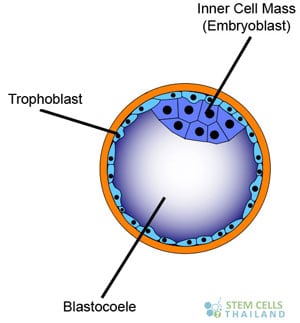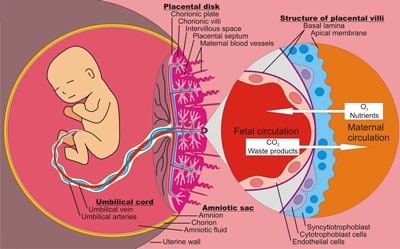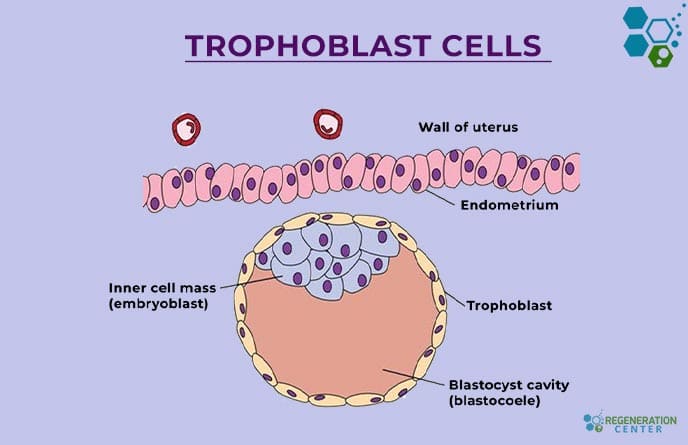Trophoblasts are the outermost cell layer of a blastocyst primarily responsible for the implantation process [1]. A trophoblast develops into extra-embryonic tissues, and these include the placenta. [2]

Trophoblasts are specialized cells that play a pivotal role in the early stages of mammalian development, particularly in the formation of the placenta. Originating from the outer layer of the blastocyst—the early stage embryo—trophoblast cells have the primary functions of facilitating embryo implantation and interfacing with the maternal endometrium to establish nutrient and waste exchange.
Types of Trophoblasts
- Cytotrophoblasts: These are the inner layer of mononucleated cells that retain their ability to divide and can differentiate into other types of trophoblasts.
- Syncytiotrophoblasts: These are multinucleated cells formed from the fusion of cytotrophoblasts. They are in direct contact with maternal blood and facilitate nutrient and gas exchange.
- Extravillous Trophoblasts: These cells invade the maternal endometrium and remodel maternal blood vessels to establish a stable blood supply to the developing fetus.
Trophoblast Differentiation
Trophoblasts also functions in controlling oxygen and metabolite exchange that transpires between the embryo and the mother [3]. Trophoblasts are also sometimes referred to as trophoderm. [4]

Regulatory Factors
- Transcription Factors: Specific transcription factors like GATA3, EOMES, and ELF5 are involved in regulating trophoblast differentiation.
- Signaling Pathways: Various cell signaling pathways like JAK/STAT, BMP, and Wnt signaling are critical in the process.
- Microenvironment: Hormones and growth factors in the uterine environment also influence trophoblast differentiation.
Applications in Regenerative Medicine
- Preeclampsia and Pregnancy-Related Disorders: Abnormalities in trophoblast differentiation and invasion are associated with pregnancy complications like preeclampsia.
- Stem Cell Research: Understanding how trophoblasts differentiate has implications in stem cell research and regenerative medicine.
- Cancer Research: Trophoblasts and cancer cells share some invasive properties, so studying trophoblasts can also inform cancer research.
Challenges and Future Directions
- Molecular Mechanisms: Although significant progress has been made, the exact molecular mechanisms governing trophoblast differentiation are not fully understood.
- Ethical Concerns: Some methods to study trophoblasts involve the use of human embryos, raising ethical questions.
- Human vs Mouse Models: Many studies use mouse models, but there are key differences in placental development between mice and humans that need to be accounted for.
During early pregnancy, the trophoblast cells undergo differentiation and invasion, which are essential for placenta formation and successful pregnancy outcome. Differentiation includes the transformation from cytotrophoblasts to syncytiotrophoblasts and extravillous trophoblasts, as mentioned above.
Published Clinical Citations
[1] ^ Hibaoui, Youssef, and Anis Feki. 2013. Human pluripotent stem cells as alternative models to study trophoblast development. Frontiers in physiology (December 17). doi:10.3389/fphys.2013.00374. https://www.ncbi.nlm.nih.gov/pubmed/24381561
[2] ^ Morales-Prieto, D M, S Ospina-Prieto, A Schmidt, W Chaiwangyen, and U R Markert. 2013. Elsevier Trophoblast Research Award Lecture: origin, evolution and future of placenta miRNAs. Placenta (December 16). doi:10.1016/j.placenta.2013.11.017. https://www.ncbi.nlm.nih.gov/pubmed/24378039
[3] ^ Red-Horse, Kristy, Yan Zhou, Olga Genbacev, Akraporn Prakobphol, Russell Foulk, Michael McMaster, and Susan J Fisher. 2004. Trophoblast differentiation during embryo implantation and formation of the maternal-fetal interface. The Journal of clinical investigation, no. 6. https://www.ncbi.nlm.nih.gov/pubmed/15372095
[4] ^ Taga, Shigeki, Junko Haraga, Mari Sawada, Aya Nagai, Dan Yamamoto, and Ryoji Hayase. 2013. A case of placental mesenchymal dysplasia. Case reports in obstetrics and gynecology (November 20). doi:10.1155/2013/265159. https://www.ncbi.nlm.nih.gov/pubmed/24349807

